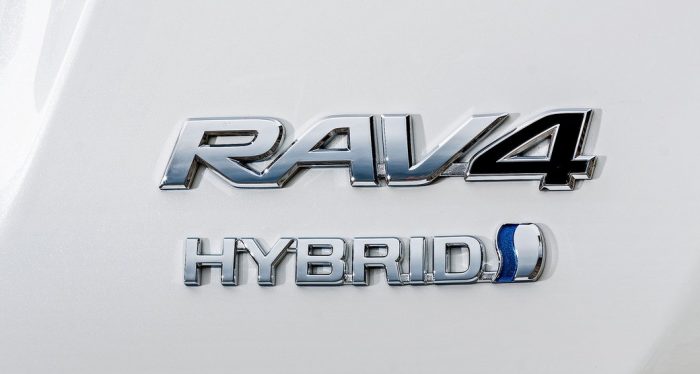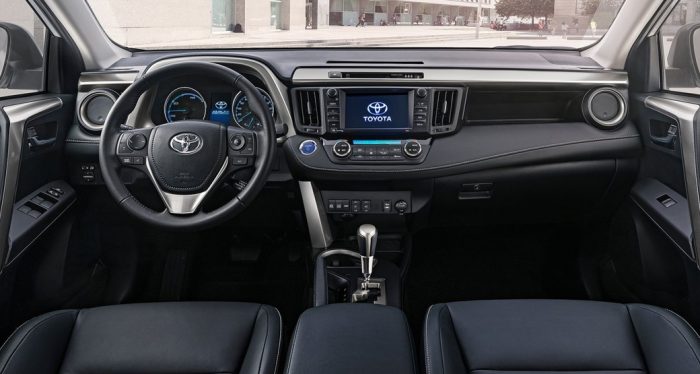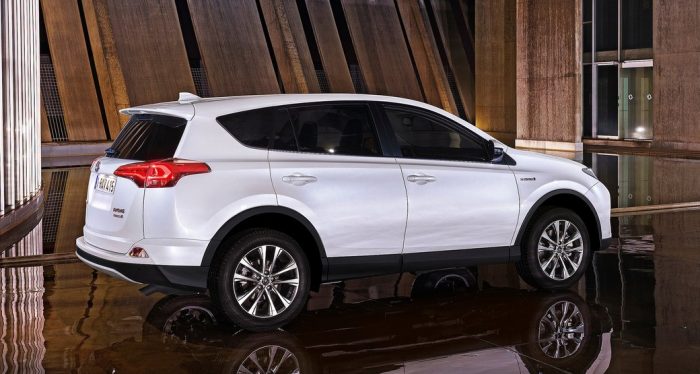By Alberto Frammartino, August 9, 2016
 With plenty of value for money, too. A new Toyota will have plenty of lifespan given its sub-£30k pricetag. However the RAV4 could never be called exciting not by any stretch of the imagination. It’s the most powerful RAV4 yet but that’s not saying all that much.
That said, what it lacks in excitement and intuitive tech, it makes up for in smart utility. With the 2016 model it could be argued it’s no longer the middle of the road SUV in terms of storage. A decent 100mm has been added to the wheelbase. Now you get more practically sized car with a roomier interior. Add a roomy, comfortable cabin and an elastic gearbox you have a car that is just plain easy to drive.
With plenty of value for money, too. A new Toyota will have plenty of lifespan given its sub-£30k pricetag. However the RAV4 could never be called exciting not by any stretch of the imagination. It’s the most powerful RAV4 yet but that’s not saying all that much.
That said, what it lacks in excitement and intuitive tech, it makes up for in smart utility. With the 2016 model it could be argued it’s no longer the middle of the road SUV in terms of storage. A decent 100mm has been added to the wheelbase. Now you get more practically sized car with a roomier interior. Add a roomy, comfortable cabin and an elastic gearbox you have a car that is just plain easy to drive.
 The RAV4 won’t be wowing anyone. It has some clunky interior design and if you want proper 4-wheel drive functionality then you will have to pay more for the privilege. That means you will have to consider a Land Rover Discovery Sport or Evoque.
The new RAV4 Hybrid AWD represents the next dimension in Toyota’s application of full hybrid technology. Its smooth and efficient powertrain combines a 2.5-litre petrol engine and an electric motor, with an additional motor powering the rear axle to deliver electronic all-wheel drive.
The AWD capability provides greater safety and stability when negotiating low-grip surfaces, It also provides a towing capacity of 1,650kg, with Toyota’s Trailer Sway Control system providing added security and peace of mind.
But the RAV4 is merely good, it delivers good quality, good levels of comfort and good practical thinking (besides the tech) make it a worthy buy. On the pantheon of C-SUVs, it’s a lesser god, certainly. It still remains popular, and some people find fun in it. It’s a comfortable, safe choice that’s not worthy of regret. Deal with the initial frustration of getting used to unintuitive design and you have a nice, breezy drive.
The RAV4 won’t be wowing anyone. It has some clunky interior design and if you want proper 4-wheel drive functionality then you will have to pay more for the privilege. That means you will have to consider a Land Rover Discovery Sport or Evoque.
The new RAV4 Hybrid AWD represents the next dimension in Toyota’s application of full hybrid technology. Its smooth and efficient powertrain combines a 2.5-litre petrol engine and an electric motor, with an additional motor powering the rear axle to deliver electronic all-wheel drive.
The AWD capability provides greater safety and stability when negotiating low-grip surfaces, It also provides a towing capacity of 1,650kg, with Toyota’s Trailer Sway Control system providing added security and peace of mind.
But the RAV4 is merely good, it delivers good quality, good levels of comfort and good practical thinking (besides the tech) make it a worthy buy. On the pantheon of C-SUVs, it’s a lesser god, certainly. It still remains popular, and some people find fun in it. It’s a comfortable, safe choice that’s not worthy of regret. Deal with the initial frustration of getting used to unintuitive design and you have a nice, breezy drive.
 RAV4’s new front is designed to generate a stronger road presence and includes full LED headlights for the first time. To the side, there is a new rocker panel that creates a more flowing look, and at the rear the combination lamps and bumper have been reworked, adding yet more emphasis to the car’s road stance.
The sensory quality of the cabin has been raised significantly with the adoption of new combination meters, a full colour TFT screen and soft-touch materials.
New technology features include Toyota’s 360-degree Panoramic View Monitor, which gives the driver sight of obstacles that would remain hidden in blind spots when using conventional front and rear cameras, making for safer and easier manoeuvring.
RAV4’s safety specification is significantly improved with the addition of the new Toyota Safety Sense suite of features. In addition to the Pre-Collision System, Lane Departure Alert, Automatic High Beam and Road Sign Assist features that will also be included in the package for new Avensis and Auris this summer, RAV4 will further benefit from Adaptive Cruise Control and two significant enhancements to the basic Pre-Collision System functions.
Firstly, the PCS will operate at an extend relative speed range – from 6 mph up to the vehicle’s maximum speed – and will be able to reduce speed through automated braking by about 24 mph. Secondly, the system will be able to detect potential collisions with pedestrians, in the event of which automated braking will operate at relative speeds between 6 mph and 50 mph and be able to reduce vehicle speed by about 19 mph.
RAV4’s new front is designed to generate a stronger road presence and includes full LED headlights for the first time. To the side, there is a new rocker panel that creates a more flowing look, and at the rear the combination lamps and bumper have been reworked, adding yet more emphasis to the car’s road stance.
The sensory quality of the cabin has been raised significantly with the adoption of new combination meters, a full colour TFT screen and soft-touch materials.
New technology features include Toyota’s 360-degree Panoramic View Monitor, which gives the driver sight of obstacles that would remain hidden in blind spots when using conventional front and rear cameras, making for safer and easier manoeuvring.
RAV4’s safety specification is significantly improved with the addition of the new Toyota Safety Sense suite of features. In addition to the Pre-Collision System, Lane Departure Alert, Automatic High Beam and Road Sign Assist features that will also be included in the package for new Avensis and Auris this summer, RAV4 will further benefit from Adaptive Cruise Control and two significant enhancements to the basic Pre-Collision System functions.
Firstly, the PCS will operate at an extend relative speed range – from 6 mph up to the vehicle’s maximum speed – and will be able to reduce speed through automated braking by about 24 mph. Secondly, the system will be able to detect potential collisions with pedestrians, in the event of which automated braking will operate at relative speeds between 6 mph and 50 mph and be able to reduce vehicle speed by about 19 mph.








